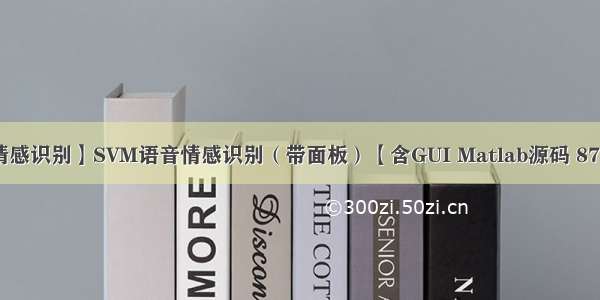
一、隐马尔可夫模型简介
隐马尔可夫模型(Hidden Markov model, HMM)是一种结构最简单的动态贝叶斯网的生成模型,它也是一种著名的有向图模型。它是典型的自然语言中处理标注问题的统计机器学模型,本文将重点介绍这种经典的机器学习模型。
1 引言
假设有三个不同的骰子(6面、4面、8面),每次先从三个骰子里面选择一个,每个骰子选中的概率为1/3,如下图所示,重复上述过程,得到一串数值[1,6,3,5,2,7]。这些可观测变量组成可观测状态链。同时,在隐马尔可夫模型中还有一条由隐变量组成的隐含状态链,在本例中即骰子的序列。比如得到这串数字骰子的序列可能为[D6, D8, D8, D6, D4, D8]。
隐马尔可夫型示意图如下所示:
图中,箭头表示变量之间的依赖关系。图中各箭头的说明如下:
在任意时刻,观测变量(骰子)仅依赖于状态变量(哪类骰子),同时t时刻的状态qt仅依赖于t-1时刻的状态qt-1。这就是马尔科夫链,即系统的下一时刻仅由当前状态(无记忆),即“齐次马尔可夫性假设”
2 隐马尔可夫模型的定义
根据上面的例子,这里给出隐马尔可夫的定义。隐马尔科夫模型是关于时序的概率模型,描述由一个隐藏的马尔可夫链随机生成不可观测的状态随机序列,再由各个状态生成一个可观测的随机序列的过程,隐藏的马尔可夫链随机生成的状态序列,称为状态序列(也就上面例子中的D6,D8等);每个状态生成一个观测,而由此产生的观测随机序列,称为观测序列(也就上面例子中的1,6等)。序列的每个位置又可以看作是一个时刻。
隐马尔可夫模型由初始的概率分布、状态转移概率分布以及观测概率分布确定。具体的形式如下,这里设Q是所有可能的状态的集合,V是所有可能的观测的集合,即有:
3 前向算法
对于步骤一的初始,是初始时刻的状态i1 = q1和观测o1的联合概率。步骤(2) 是前向概率的递推公式,计算到时刻t+1部分观测序列为o1,o2,…,ot,ot+1 且在时刻t+1处于状态qi的前向概率。如上图所示,既然at(j)是得到时刻t观测到o1,o2,…,ot并在时刻t处于状态的qj前向概率,那么at(j)aji就是到时刻t观测到o1,o2,…,ot并在是时刻t处于qj状态而在时刻t+1到达qi状态的联合概率。对于这个乘积在时刻t的所有可能的N个状态求和,其结果就是到时刻t观测为o1,o2,…,ot,并在时刻t+1处于状态qi的联合概率。最后第三步,计算出P(O|lamda)的结果。
当然这里只是介绍了诸多算法中的一种,类似的还有后向算法(大家可以看相关的书籍进行了解)。对于动态规划的解决隐马尔科夫模型预测问题,应用最多的是维特比算法。
二、部分源代码
function varargout = HMM_VoiceRecognation(varargin)% HMM_VOICERECOGNATION MATLAB code for HMM_VoiceRecognation.fig%HMM_VOICERECOGNATION, by itself, creates a new HMM_VOICERECOGNATION or raises the existing%singleton*.%%H = HMM_VOICERECOGNATION returns the handle to a new HMM_VOICERECOGNATION or the handle to%the existing singleton*.%%HMM_VOICERECOGNATION('CALLBACK',hObject,eventData,handles,...) calls the local%function named CALLBACK in HMM_VOICERECOGNATION.M with the given input arguments.%%HMM_VOICERECOGNATION('Property','Value',...) creates a new HMM_VOICERECOGNATION or raises the%existing singleton*. Starting from the left, property value pairs are%applied to the GUI before HMM_VoiceRecognation_OpeningFcn gets called. An%unrecognized property name or invalid value makes property application%stop. All inputs are passed to HMM_VoiceRecognation_OpeningFcn via varargin.%%*See GUI Options on GUIDE's Tools menu. Choose "GUI allows only one%instance to run (singleton)".%% See also: GUIDE, GUIDATA, GUIHANDLES% Edit the above text to modify the response to help HMM_VoiceRecognation% Last Modified by GUIDE v2.5 07-Jan- 20:30:18% Begin initialization code - DO NOT EDITgui_Singleton = 1;gui_State = struct('gui_Name', mfilename, ...'gui_Singleton', gui_Singleton, ...'gui_OpeningFcn', @HMM_VoiceRecognation_OpeningFcn, ...'gui_OutputFcn', @HMM_VoiceRecognation_OutputFcn, ...'gui_LayoutFcn', [] , ...'gui_Callback', []);if nargin && ischar(varargin{1})gui_State.gui_Callback = str2func(varargin{1});endif nargout[varargout{1:nargout}] = gui_mainfcn(gui_State, varargin{:});elsegui_mainfcn(gui_State, varargin{:});end% End initialization code - DO NOT EDIT% --- Executes just before HMM_VoiceRecognation is made visible.function HMM_VoiceRecognation_OpeningFcn(hObject, eventdata, handles, varargin)% This function has no output args, see OutputFcn.% hObject handle to figure% eventdata reserved - to be defined in a future version of MATLAB% handles structure with handles and user data (see GUIDATA)% varargin command line arguments to HMM_VoiceRecognation (see VARARGIN)% Choose default command line output for HMM_VoiceRecognationhandles.output = hObject;% Update handles structureguidata(hObject, handles);% UIWAIT makes HMM_VoiceRecognation wait for user response (see UIRESUME)% uiwait(handles.figure1);% --- Outputs from this function are returned to the command line.function varargout = HMM_VoiceRecognation_OutputFcn(hObject, eventdata, handles) % varargout cell array for returning output args (see VARARGOUT);% hObject handle to figure% eventdata reserved - to be defined in a future version of MATLAB% handles structure with handles and user data (see GUIDATA)% Get default command line output from handles structurevarargout{1} = handles.output;% --- Executes on button press in button_choose.function button_choose_Callback(hObject, eventdata, handles)% hObject handle to button_choose (see GCBO)% eventdata reserved - to be defined in a future version of MATLAB% handles structure with handles and user data (see GUIDATA)% fname: 返回文件名% panme: 返回文件路径名% index: 选择的文件类型global fnameglobal pname[fname, pname, index] = uigetfile( {'*.wav', '选择语音文件'} ) ;set( handles.button_reco, 'Enable', 'on' ) % --- Executes on button press in button_reco.function button_reco_Callback(hObject, eventdata, handles)% hObject handle to button_reco (see GCBO)% eventdata reserved - to be defined in a future version of MATLAB% handles structure with handles and user data (see GUIDATA)global fnameglobal pnameglobal strfilename = strcat( pname, '\\', fname ) ;load('hmm.mat')% 发音[ y, fs ] = audioread(filename) ;sound(y, fs) ;% 识别x = wavread(filename);[x1 x2] = vad(x);m = mfcc(x);m = m(x1-2:x2-2,:);for j=1:10pout(j) = viterbi(hmm{j}, m);end[d,result_index] = max(pout);%在static text里显示结果if result_index == 10% --- Executes on button press in button_exit.function button_exit_Callback(hObject, eventdata, handles)% hObject handle to button_exit (see GCBO)% eventdata reserved - to be defined in a future version of MATLAB% handles structure with handles and user data (see GUIDATA)clear allclose% --- Executes on selection change in listbox1.function listbox1_Callback(hObject, eventdata, handles)% hObject handle to listbox1 (see GCBO)% eventdata reserved - to be defined in a future version of MATLAB% handles structure with handles and user data (see GUIDATA)% Hints: contents = cellstr(get(hObject,'String')) returns listbox1 contents as cell array% contents{get(hObject,'Value')} returns selected item from listbox1% --- Executes during object creation, after setting all properties.function listbox1_CreateFcn(hObject, eventdata, handles)% hObject handle to listbox1 (see GCBO)% eventdata reserved - to be defined in a future version of MATLAB% handles empty - handles not created until after all CreateFcns calledfunction edit1_Callback(hObject, eventdata, handles)% hObject handle to edit1 (see GCBO)% eventdata reserved - to be defined in a future version of MATLAB% handles structure with handles and user data (see GUIDATA)% Hints: get(hObject,'String') returns contents of edit1 as text% str2double(get(hObject,'String')) returns contents of edit1 as a double% --- Executes during object creation, after setting all properties.function edit1_CreateFcn(hObject, eventdata, handles)% hObject handle to edit1 (see GCBO)% eventdata reserved - to be defined in a future version of MATLAB% handles empty - handles not created until after all CreateFcns called% Hint: edit controls usually have a white background on Windows.% See ISPC and COMPUTER.if ispc && isequal(get(hObject,'BackgroundColor'), get(0,'defaultUicontrolBackgroundColor'))set(hObject,'BackgroundColor','white');end% --- Executes on button press in button_clear.function button_clear_Callback(hObject, eventdata, handles)% hObject handle to button_clear (see GCBO)% eventdata reserved - to be defined in a future version of MATLAB% handles structure with handles and user data (see GUIDATA)function f=enframe(x,win,inc) %ENFRAME split signal up into (overlapping) frames: one per row. F=(X,WIN,INC) % %F = ENFRAME(X,LEN) splits the vector X up into %frames. Each frame is of length LEN and occupies %one row of the output matrix. The last few frames of X %will be ignored if its length is not divisible by LEN. %It is an error if X is shorter than LEN. % %F = ENFRAME(X,LEN,INC) has frames beginning at increments of INC %The centre of frame I is X((I-1)*INC+(LEN+1)/2) for I=1,2,... %The number of frames is fix((length(X)-LEN+INC)/INC) % %F = ENFRAME(X,WINDOW) or ENFRAME(X,WINDOW,INC) multiplies %each frame by WINDOW(:) %% %%%%%%%%%%%%%%%%%%%%%%%%%%%%%%%%%%%%%%%%%%%%%%%%%%%%%%%%%%%%%%%%%%%%%%%%%%%%%%%%% %%%%%%%%%%%%%%%%%%%%%%%%%%%%%%%%%%%%%%%%%%%%%%%%%%%%%%%%%%%%%%%%%%%%%%%%%%%%%%%%% nx=length(x); nwin=length(win); if (nwin == 1) len = win; else len = nwin; end if (nargin < 3) inc = len; end nf = fix((nx-len+inc)/inc); f=zeros(nf,len); indf= inc*(0:(nf-1)).'; inds = (1:len); f(:) = x(indf(:,ones(1,len))+inds(ones(nf,1),:)); if (nwin > 1) w = win(:)'; f = f .* w(ones(nf,1),:); end
三、运行结果
四、matlab版本及参考文献
1 matlab版本
a
2 参考文献
[1]韩纪庆,张磊,郑铁然.语音信号处理(第3版)[M].清华大学出版社,.
[2]柳若边.深度学习:语音识别技术实践[M].清华大学出版社,.
















